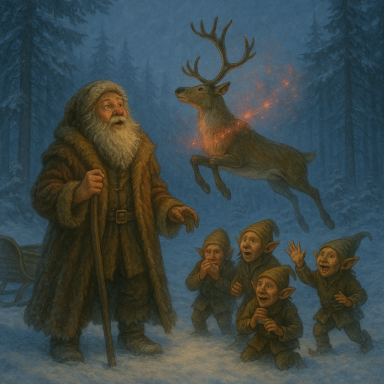
The First to Fly
(September 1512)
An early tale of Neik Klass, First Santa of the North
By his third winter on Evela, Neik Klass no longer walked every snowy mile with aching feet and frostbitten cheeks. His sleigh, carved by Shoe Elves in Cobblerton, had grown sturdier, sleeker, and more beautiful with each passing season. But while it slid gracefully over land, it was still bound to the ground—until something changed everything.
It began when Skit, a jittery and ingenious Shoe Elf, appeared at Santa’s workshop with a pouch of glowing crimson powder.
“From a mushroom ring near the Deep Hollows,” Skit said, wide-eyed. “Made a squirrel hum lullabies and three frogs start a barbershop quartet.”
That powder—later confirmed by the Fairy Sage Forlot—was red fairy dust, an unstable byproduct of dimensional travel. Fairies called it a byproduct of wonder. Elves just called it dangerous.
But Neik saw its potential.
With guidance from Forlot and a dedicated team in Tracker and Reindeer villages, Neik and the elves began a methodical series of trials known now as the Fairy Dust Experiments. The goal? Flight.
They fed enchanted forage—lichen, moss, mushrooms, and rye grain—infused with fairy dust to selected reindeer. After weeks of tests, they discovered the key:
One ounce of red fairy dust per ten pounds of feed.
Duration: ~36 hours.
Side effects: minor floating, occasional midair sneezing.
But a new problem emerged. Even as the reindeer began to rise, the sleigh itself—laden with toys—was too heavy. The team strained and hovered, but couldn’t lift it for long-distance travel.
That’s when Neik remembered something Forlot had told him:
“Fairy dust responds to purpose. Not just ingredients—Intent.”
Neik conducted one final test: he added red fairy dust to a fresh batch of bright red sleigh paint, stirred it with intention, and brushed it lovingly onto the sleigh’s frame. The result was instant—not just in color, but in lightness. Though still solid and sturdy, the sleigh felt ready to fly, as if it had already dreamed of the sky.
The sleigh now shimmered like a red gem, and the reindeer responded.
And so, on a brilliant December morning, eight reindeer stood yoked in the sleighyard, their breath curling in the air. They had eaten their enchanted feed precisely one hour earlier. Their names would go down in history:
- Brisket – strong and unshakable
- Frostmane – quick and agile
- Hearth – calm and enduring
- Thistle – brave and spirited
- Mirth – lively and joyful
- Beryl – graceful and swift
- Tunra – sharp and perceptive
- Solace – gentle and quietly courageous
The first to rise was Thistle, startled by her own upward drift. Then Tunra, then Mirth. One by one, the team rose like snowflakes caught in an upward wind.
Santa climbed aboard the painted sleigh, now almost weightless in their wake.
He grasped the reins. “Fly,” he said—not as a command, but as a wish.
And they did.
They arced over the Great Fir Tree, soared past the chimneys of Tracker Village, and crossed the Rootbeer River in under a minute. The test flight lasted only an hour, but its legacy would stretch through centuries.
Epilogue
To this day, red fairy dust is stored in silver canisters, measured with reverence by the Reindeer Corps. The sleigh, now reborn many times over, is always painted red—not just for tradition, but to retain the magic.
No one knows exactly how much fairy dust is needed in the paint. Only that it must be enough… and applied with Intent.
And always, the feed ratio remains the same:
One ounce per ten pounds.
And only, when it’s time to fly.
©Copyright 2025. All rights reserved.
We need your consent to load the translations
We use a third-party service to translate the website content that may collect data about your activity. Please review the details in the privacy policy and accept the service to view the translations.